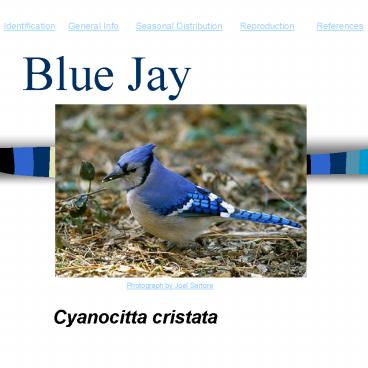Blue Jay - PowerPoint PPT Presentation
1 / 9
Title:
Blue Jay
Description:
Blue Jay. Cyanocitta cristata. Seasonal Distribution. Photograph ... The song of a Blue Jay varies but the most common is a shrill, descending 'jaaaaay' sound. ... – PowerPoint PPT presentation
Number of Views:291
Avg rating:3.0/5.0
Title: Blue Jay
1
Blue Jay
Seasonal Distribution
Reproduction
Identification
References
General Info
Photograph by Joel Sartore
- Cyanocitta cristata
2
Identification
Blue Jays have blue feathers on upper side of
body with whitish feathers on underside. They
have white patches on wings and tails and a black
band around their necks. Length 11
inches Wingspan 16 inches Weight 3 oz (85g)
- Songs
Home
3
General Information
- Order Passeriformes. Family Corvidae.
- The blue color of the feathers are not from a
pigment, but structural colors created by the
coherent scattering of light waves - They have a multipurpose bill, allowing them to
eat many different types of food, and therefore
stay in the same general area despite certain
resource deficiencies. In general, they are
omnivorous, eating nuts, seed, insects, eggs, and
even small animals. - They live in oak and pine woods as well as
suburban areas. - They are capable of learned behaviors. After
eating a poisonous butterfly and vomiting, they
learn never to eat that type again. They are
also capable of insight learning, where they
learn by watching other jays.
Home
4
Seasonal Distribution
BBC Map (summer distribution)
Next
Home
5
Seasonal Distribution
CBC Map (winter distribution)
Home
Next
6
Seasonal Abundance
Figure 1. Seasonal Abundance of Blue Jays
observed during the spring of 2007.
Home
7
Songs
The song of a Blue Jay varies but the most common
is a shrill, descending jaaaaay sound. They
also produce a whistling toolili noise as well
as a quiet rattling sound. They also
occasionally learn to mimic Red-tailed,
Red-shouldered, and Broad-winged Hawks.
Toolili call
Jaaaay song
Series of songs
Home
8
Reproduction
- Parents are monogamous and stay together
year-round. - Nests are built in trees and shrubs usually 10-40
ft from ground. - Nest is in the shape of a cup and consists of
twigs, grass, paper, feathers, and possibly mud.
It is built by both sexes. - Eggs are small and vary in color and speckle
patterns. They are incubated by female for 16-18
days. - Nestlings are naked and are fed by both parents.
They generally leave the nest after 17-21 days,
but parents may continue to feed them for another
1-2 months.
Home
9
References
- Alcock, J. 2004. Understanding Bird Behavior.
In Handbook of Bird Biology (S. Podulka, R.
Rohrbaugh, Jr., and R. Bonney, eds). The Cornell
Lab of Ornithology New York. - Baicich, P.J., and C. Harrison. 1997. A Guide
to the Nests, Eggs, and Nestlings of North
American Birds. Natural World Academic Press
San Diego. - Bird Web
- Clark, G.A. 2004. Form and Function The
External Bird. In Handbook of Bird Biology (S.
Podulka, R. Rohrbaugh, Jr., and R. Bonney, eds).
The Cornell Lab of Ornithology New York. - Evans, H.E. and J.B. Heiser. 2004. Whats
Inside Anatomy and Physiology. In Handbook of
Bird Biology (S. Podulka, R. Rohrbaugh, Jr., and
R. Bonney, eds). The Cornell Lab of
Ornithology New York. - Gill, F.B. 2007. Ornithology. W.H. Freeman and
Company New York. - Sibley, D.A. 2000. National Audubon Society
The Sibley Guide to Birds. Chanticleer Press,
Inc. New York. - Temple, S.A. 2004. Individuals, Populations,
and Communities The Ecology of Birds. In
Handbook of Bird Biology (S. Podulka, R.
Rohrbaugh, Jr., and R. Bonney, eds). The
Cornell Lab of Ornithology New York. - Winkler, D.W. 2004. Nests, Eggs, and Young
Breeding Biology of Birds. In Handbook of Bird
Biology (S. Podulka, R. Rohrbaugh, Jr., and R.
Bonney, eds). The Cornell Lab of Ornithology
New York.
Home































